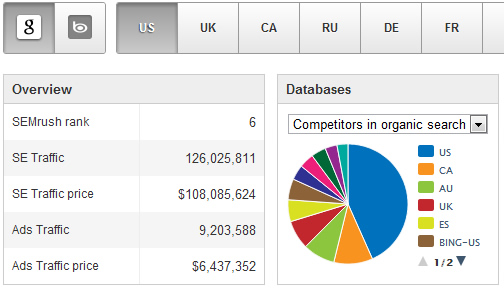
There are a lot of moving parts to developing and managing SEM campaigns. First, you need to develop a strong paid search strategy, perform keyword research, map out a robust structure for your campaigns and ad groups, determine budgets, create effective ads, etc. After the setup phase, you will be neck deep in ongoing campaign management, which involves refining your campaigns and ad groups based on performance. That includes refining keywords, ads, creating new ad groups when necessary, pausing ad groups or campaigns that don’t perform well, split testing ads, etc. This includes managing both Search and Display Network campaigns. As you can guess, SEM is definitely not for the faint of heart.
Based on all that’s involved with paid search, I think it’s easy for SEM’s to keep driving campaigns forward without taking a step back to analyze the competitive landscape. For example, which companies are you competing against in SEM, which ads are they running, what types of landing pages are they using, how does their pricing stack up, etc. That’s where a thorough competitive analysis can pay huge dividends. There are so many important things you can learn from analyzing the competition that I’m surprised more companies aren’t doing it.
In this post, I’m going to explore five important insights you can learn from performing an SEM competitive analysis. My hope is that once you read through this post, you’ll be eager to get started on your own analysis. Let’s get started.
What’s an SEM Competitive Analysis?
Simply put, an SEM competitive analysis enables you to understand the companies also bidding on the same keywords and categories you are targeting in paid search. Let’s face it, if you are bidding on a set of keywords, it’s important to understand which competitors are targeting the same keywords, where they are driving visitors, how aggressively they are bidding, the pricing they are providing for similar products, etc. While performing the analysis, there are times you find incredible nuggets of information that can help enhance your own campaigns. You can also understand why certain competitors might be outperforming your own efforts.
Competitive Analysis Tools
This post isn’t meant to provide a tutorial on how to use the various competitive tools in the industry. There are many to choose from and you should test them out to determine which ones fit your needs. Pricing-wise, some are paid solutions while others are offered for free. For example, SEMRush and SpyFu are two paid solutions that enable you to view a wealth of competitive SEM data such as keywords, ads, cpc’s, volume of traffic, etc.
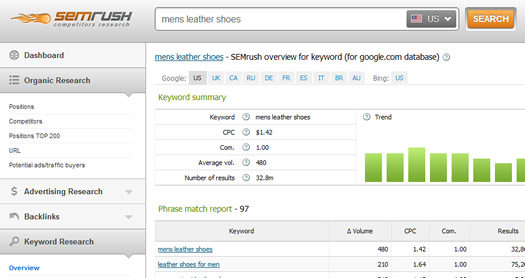
Google’s Ad Preview Tool is free and enables you to view an unpersonalized SERP, while also enabling you to specify geographic location, mobile vs. desktop, language, etc. In addition, AdWords recently released Auction Insights, which gives you a view of the companies you are competing with on a keyword level (if there is enough data). You can view a competitor’s impression share, their avg position, the overlap rate, the percentage of times they rank above your own ads, etc. Again, there are many tools on the market, and my recommendation is to figure out the right combination for your needs. Many of the paid solutions have free trials, so you can start using them immediately to gauge their effectiveness.
A screenshot from the Google Ad Preview Tool:
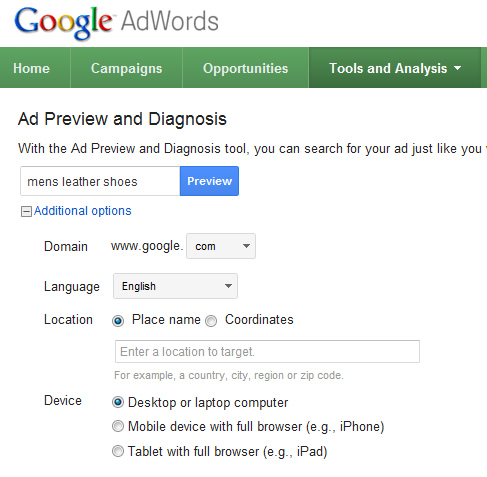
Analysis Scope
When determining the scope of your analysis, you can either start small and analyze a specific ad group, or you can analyze a larger campaign (or set of campaigns). If you are just starting out, you might want to start smaller and just focus on an important ad group. Once you determine the best process to use, along with the right tools, you can expand to other ad groups and larger campaigns. I recommend choosing an ad group that’s important to your business, but one that might not be performing very well. You never know, the competitive analysis could reveal why that is…
Let’s take a look at five things you can learn from an SEM competitive analysis that can greatly help your own SEM efforts:
1. Who Are Your *Real* Competitors (in Search)
Whenever I begin helping a new client, I always ask them who their top competitors are. It’s a trick question, since the standard set of competitors in the industry might not be the same competitors in SEM (or SEO). Understanding which companies are present in the SERPs for target keywords is extremely important. For consumers that don’t know which company to do business with, and start searching Google, the offline competition might not make a big difference. That’s why you need to understand your true competitors in SEM. That’s who prospective customers will be reviewing while researching online.
When I present my findings with regard to true competition, it’s not uncommon for my clients to fall out of their chairs. Sure, they might find some familiar faces, but they might find some additional companies or websites that surprise them. For example, say hello to Amazon.com, the biggest and baddest ecommerce retailer on the web. If you are selling online, Amazon very well could be a core competitor in SEM. If that’s the case, you better check out pricing on Amazon.com, how often they show up for your target keywords, which third party sellers are providing similar products, etc. Let’s face it, low pricing and Amazon Prime membership is a killer combination that you’ll have to face and deal with at some point. And you’re not alone.
You also might find comparison shopping sites, forums, answer-driven sites like Yahoo Answers, personal blogs, etc. If you do, you might need to form a strategy for monitoring those sites to ensure you are represented (the right ways). You might find manufacturer websites that provide links to online retailers that offer their products. Are you listed there? Should you be? I think you get the picture. Understand the real competition, dig deeper, and form a strategy for dealing with those “competitors”.
A list of competitors in AdWords for a target keyword:
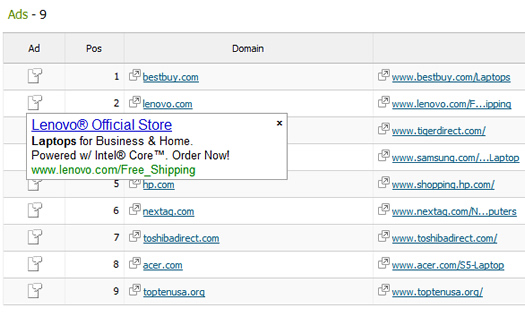
2. Find the Keywords Your Competitors are Running
OK, so now you know which companies you are competing with in SEM. Your next question might focus on which keywords they are running. This is important for several reasons. First, you want to make sure you aren’t missing important keywords or categories that customers are searching for. Even if you performed keyword research, you might have missed something. Analyzing keywords your competitors are running could help close the gaps.
Analyzing the keywords a competitor is bidding on:
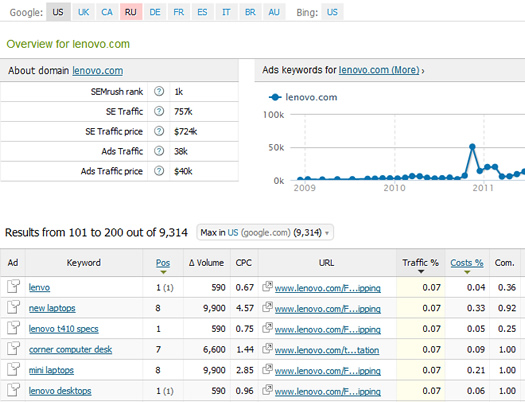
Second, you can start to gauge how much traffic each keyword or keyword category is driving to your competitors’ websites. For example, if you see a larger percentage of traffic for certain categories, there might a good reason for that. Maybe they are seeing outstanding performance from those keywords or categories, and they are allocating more budget to those keywords.
Note: there are many companies not managing SEM correctly, so be careful here… If you see something stand out while analyzing the keywords that competitors are running, you can and should, test those yourself. As long as you have a strong analytics strategy in place, you can easily identify high quality traffic, strong performance, etc. I guess what I’m saying is that keyword intelligence is great to attain, but nothing compares to actual testing.
3. Competitor Landing Pages
Next on our list are the landing pages that competitors are using. Let’s say you were running an ad group for an important category. You are getting a lot of traffic, but not many conversions. You’re baffled why that is… Well, analyzing the landing pages that competitors are using can tell you a lot. Are they driving visitors to product detail pages, campaign landing pages, lead generation pages focused on gaining contact information, mobile landing pages (for mobile traffic), etc? All of this can help you better understand why your competitors might be outperforming you in SEM.
Understanding the landing page experience for prospective customers can help you form ideas for your own landing pages. If you are driving visitors to a product detail page and competitors have set up dedicated campaign landing pages with a wealth of information, images, video, reviews, live chat, etc., you might want to refine your efforts. Don’t pale in comparison to your competition. It could be the very reason you are seeing less conversion (or no conversion).
A sample SEM landing page:
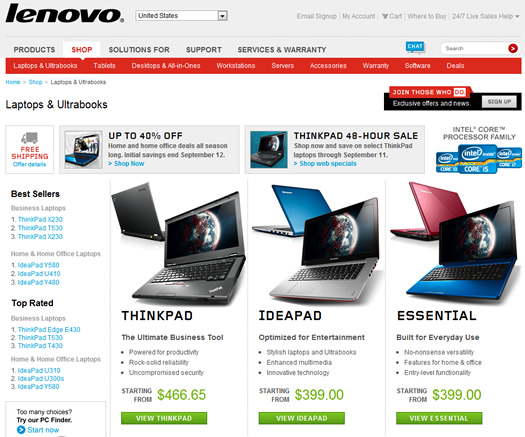
4. Ads, Ad Extensions, and PLA’s
Using competitive tools, you can review the text ads that competitors are running. When prospective customers are facing a SERP filled with paid ads, it’s important to stand out (for the right reasons). Are your competitors punching sales, deals, special offers, etc? Are they providing actual pricing in their ads? Are competitor text ads aligned with the landing pages they are driving visitors to? All of this can help you understand why your own performance isn’t as strong as it should be.
Viewing competitor text ads:
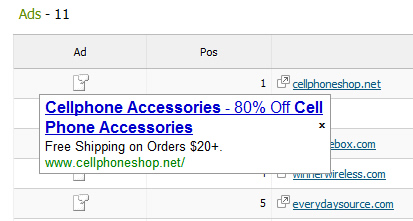
And let’s not forget about ad extensions and product listing ads. Are your competitors using sitelinks extensions, product extensions, call extensions, local extensions, social extensions, etc? The extra information provided by ad extensions can be extremely valuable to prospective customers. For example, you can drive visitors deeper to certain sections of your site, to specific products pages, show social connections, click to call phone numbers, etc. And if you’re an ecommerce retailer, don’t overlook the power of seller rating extensions. Those little stars can bring a level of credibility that can mean the difference between revenue or just a click.
An example of sitelinks extensions in AdWords:
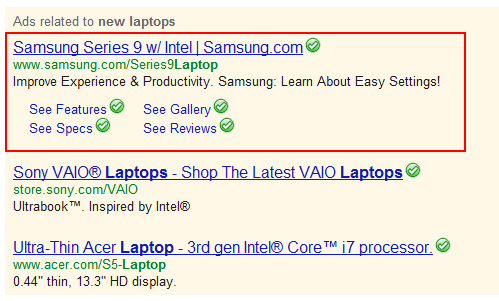
In addition to what I mentioned above, I have to cover the power of product listing ads. Recently, Google transitioned Google Shopping to a pure paid model. Product listing ads are an important part of that model, and are extremely powerful. They are image-based ads for specific products, based on your merchant center feed. They are CPC-based and can help drive strong performance for ecommerce retailers. If your competitors are running PLA’s, and you aren’t, you better get in the game. There are times text ads just don’t compare to the image-based PLA’s competing for attention in the SERPs.
An example of product listings ads in action:
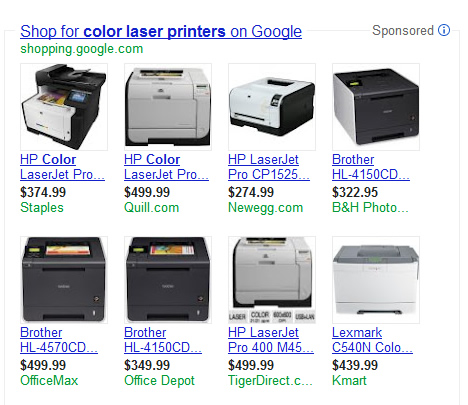
5. Pricing
The final insight I’m going to cover is probably the most important – pricing. Performing a competitive analysis will reveal the pricing your competition is providing for the same products you are selling. The power of the internet is a double edged sword for many sellers. You can now compete with the big boys, but you will also be compared with every other seller on the web. And this can happen in mere seconds as people research products via Google, Bing, and Yahoo.
I find this step in a competitive analysis provides incredibly important insights for my clients. They are sometimes floored by what they are seeing. Actually, it’s not unusual for some clients to start yelling as I’m presenting my findings. “How are they providing that pricing?” “That can’t be right.” “They are lowballing prospective customers!” I’ve heard every possible comment under the sun.
Regardless, unless a consumer knows and trusts your company, you are going to have a hard time comparing to a competitor selling the same product at 20% lower than your own pricing. Not every person will go with the lowest price (based on a number of credibility factors), but some will. And when you are paying for every click, it’s important to keep those visitors on your site with the hope of converting them.
Analyzing competitor pricing:

My recommendation is to analyze each of the competitors for a category, and break down the pricing for each. Try and determine if that’s the real pricing, how they are providing that pricing, understand their shipping costs, etc., and then form a strategy for dealing with the situation. By the way, that could mean pausing your ad groups for that category. If your ROI is pitiful, and your competitors are selling at pricing that makes no sense, then pause your ad groups. You can find other more profitable categories to drive…
Summary – Competitive Data is There. Go Analyze It
Are you ready to get rolling with your own competitive analysis? As I covered above, there’s a lot you can learn. It’s important that you don’t get so caught up in your own campaigns that you forget to learn what your competition is running, how much they are spending, where they are driving visitors, and what type of landing pages they are using. You never know, you might end up finding serious gaps in your own campaigns. And that can lead to more revenue, profit, and a stronger ROI. Good luck.
GG
